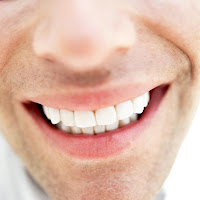 Stained teeth in themselves are not really a health hazard, but they can be an annoyance. Even worse, they can prompt you to do damaging things in an attempt to whiten them.
Stained teeth in themselves are not really a health hazard, but they can be an annoyance. Even worse, they can prompt you to do damaging things in an attempt to whiten them.Some stains can be removed by your twice-yearly cleaning, while others may require more aggressive treatment. Still other stains may be almost impossible to remove. The best way to keep your teeth their whitest is to avoid staining them in the first place.
A variety of factors can contribute to or cause stained teeth. Some of the more common tooth stainers are cigarette smoke, chewing tobacco, and habitual coffee and tea drinking. Extensive decay and dead nerves may also cause some discoloration. Plaque left by improper or infrequent flossing and brushing is a magnet for foods that stain (remember, plaque is sticky stuff). And, of course, age -- that notorious thief of beauty -- robs your teeth of their original brilliant white color, leaving them slightly yellowed.
Exposure to certain drugs (such as the antibiotic tetracycline) either in utero or as a small child, can leave teeth a pearly gray. Excessive childhood ingestion of fluoride may also cause the enamel to appear mottled and uneven. These types of stains are often the most difficult to remove, although they may improve somewhat with the aid of a professional bleaching.
Here are some ideas to brighten your smile:
Stick to your brushing and flossing regimen. (You knew that was coming, didn't you?) Once again, conscientious brushing and flossing win -- hands down -- as the best ways to prevent dental problems, including staining.
Avoid all forms of tobacco use, including pipes, cigars, chewing tobacco, and snuff.
Cut down on your intake of coffee and tea. The less contact these fluids have with your teeth, the less opportunity they will have to leave stains.
Disguise it. If you have a dark, highly visible amalgam filling (and a little disposable income), consider having it replaced with a tooth-colored plastic composite. A porcelain crown can also cover up a badly discolored or decayed tooth.
Treat yourself to an extra cleaning or two. Keep your teeth whiter (and your hygienist happier) by scheduling visits just for professional cleanings. Extra cleanings may help prevent long-term staining.
Get your teeth professionally bleached. Several excellent technologies have emerged for bleaching and whitening the teeth. Although some of these procedures must be performed in the dentist's office, a few can be done at home. Ask your dentist what he or she recommends.
The following are some definite tooth-whitening don'ts:
Don't take aggressive measures on your own. You may end up compounding your problem. If your teeth are heavily stained or discolored, consult your dentist.
Always consult your dentist before using an at-home whitening kit.
Never use any amount of chlorine bleach on your teeth. It is highly toxic.
Don't overdo it with "whitening" toothpastes. Some stain-removing toothpastes are quite abrasive and can wear off enamel if used too often. Consult your dentist or dental hygienist before using these toothpastes.
Your teeth need lots of care and attention to ensure life-long good oral health. Visit the links below for more information about protecting and caring for your teeth.
If you're not vigilant in your oral hygiene, an assortment of afflictions can attack your teeth and gums. Learn more in How Dental Disease Works.
Do you wish your teeth had just a bit more sparkle to them? How Tooth Whitening Works takes a look at procedures you can undergo to brighten your pearly whites.
When you have an ache in your teeth, getting rid of it is the only thought in your head. In How to Relieve a Tooth Ache, find out how to deal with dental distress.
This information is solely for informational purposes. IT IS NOT INTENDED TO PROVIDE MEDICAL ADVICE. Neither the Editors of Consumer Guide (R), Publications International, Ltd., the author nor publisher take responsibility for any possible consequences from any treatment, procedure, exercise, dietary modification, action or application of medication which results from reading or following the information contained in this information. The publication of this information does not constitute the practice of medicine, and this information does not replace the advice of your physician or other health care provider. Before undertaking any course of treatment, the reader must seek the advice of the

No comments:
Post a Comment